Web Equipment, Pattern 1908, Officers
Equipment Carriers
CARRIERS, AMMUNITION & COMPASS
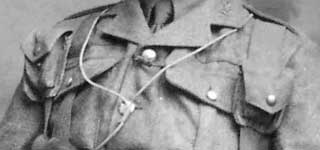 The listing of Carriers, ammunition and compass is interpreted to mean two pouches, of identical form, one probably padded. The term “Carrier” seems unusual, with existing and later nomenclatures matching “Case” to the compass and “Pocket” to pistol ammunition. However, it does allow a one line Vocabulary entry, for items that would not have been commonly encountered, but would still need to be accounted for!
The listing of Carriers, ammunition and compass is interpreted to mean two pouches, of identical form, one probably padded. The term “Carrier” seems unusual, with existing and later nomenclatures matching “Case” to the compass and “Pocket” to pistol ammunition. However, it does allow a one line Vocabulary entry, for items that would not have been commonly encountered, but would still need to be accounted for!
The Carriers ought to have attached to the Belt by “C” hooks, but could have had narrow webbing belt loops, or maybe transverse Brace loops. The photo shows two such pouches, possibly cut from Patt. ’08 Cartridge carriers, as a “user-mod”. However, if Mills were to have produced these, it would make complete sense to re-programme the looms and weave runs of single pockets - of exactly this form. This detail is taken from a photograph in Stephen J. Chambers' monumental Uniforms & Equipment of the British Army in World War I: A Study in Period Photographs (Schiffer Publishing Ltd., Atglen, Pa., 2005). This photo shows an officer wearing what may be Web Equipment, Pattern 1908, Officers.
CASES, FIELD-GLASS, LEATHER LINED

 An archaic nomenclature forms part of the Case, field-glass, leather lined, since Ross had been advertising “prismatic binoculars” as early as 1900. Today, the term “field glasses” suggest the paired beer-bottle shape and “binoculars” the type with roof prisms. However, the terminology was less precise then. The Case is presumed to be shaped, in the manner of leather versions, but with a simple flap secured by a press fastener mounted in the flap. Small weather flaps, under the main flap, would then have made it more weatherproof. The 1910 Mills Patent shows a Binocular case (far left), although this was retained to the belt by hooks blanked and pressed from brass strip (rather than wire), which were riveted to the Case. It could even have been identical to the envelope used on W.E., Officers, Experimental (interior, showing leather lining, near left). This example is maker marked "M.E. Co." and dated 1917. From the Paul Hannon Collection.
An archaic nomenclature forms part of the Case, field-glass, leather lined, since Ross had been advertising “prismatic binoculars” as early as 1900. Today, the term “field glasses” suggest the paired beer-bottle shape and “binoculars” the type with roof prisms. However, the terminology was less precise then. The Case is presumed to be shaped, in the manner of leather versions, but with a simple flap secured by a press fastener mounted in the flap. Small weather flaps, under the main flap, would then have made it more weatherproof. The 1910 Mills Patent shows a Binocular case (far left), although this was retained to the belt by hooks blanked and pressed from brass strip (rather than wire), which were riveted to the Case. It could even have been identical to the envelope used on W.E., Officers, Experimental (interior, showing leather lining, near left). This example is maker marked "M.E. Co." and dated 1917. From the Paul Hannon Collection.
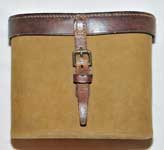
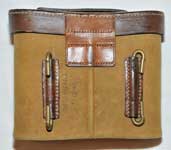
 Views of the leather & khaki duck Binocular case mentioned in the Introduction. This leather Binocular case has had khaki duck (not khaki drill) bonded to it, then 3 inch “C” hooks on leather chapes added. The average clerk looking at this may well have described this as Cases, field-glass, leather-lined. Where’s the leather? On the inside, ergo it’s leather-lined! From the Paul Hannon Collection. Photos this section © Paul Hannon 2010.
Views of the leather & khaki duck Binocular case mentioned in the Introduction. This leather Binocular case has had khaki duck (not khaki drill) bonded to it, then 3 inch “C” hooks on leather chapes added. The average clerk looking at this may well have described this as Cases, field-glass, leather-lined. Where’s the leather? On the inside, ergo it’s leather-lined! From the Paul Hannon Collection. Photos this section © Paul Hannon 2010.
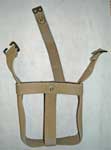
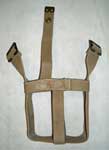 These were priced at 1,, 11d, thruppence cheaper than Patt. ’08 W.E.. However, the 1920 Priced Vocabulary makes no distinction between the various issues of Patt. ’08 Haversack, some of which may still have been in service. It is therefore felt that 2 “ 2d might represent a “catch-all” price. The Officer’s version would probably
have been calculated for a discrete variant, i.e. one with no provision for attachment to the Haversack. This probably accounts for the difference.The OR's Patt. '08 Waterbottle carrier shown here is maker marked "M.E. Co." and dated 1915. This example is a third issue version, as supplied from 1914 - 1921, and like the officers' issue has no provision for carrying on the Haversack. From the Karkee Web Collection.
These were priced at 1,, 11d, thruppence cheaper than Patt. ’08 W.E.. However, the 1920 Priced Vocabulary makes no distinction between the various issues of Patt. ’08 Haversack, some of which may still have been in service. It is therefore felt that 2 “ 2d might represent a “catch-all” price. The Officer’s version would probably
have been calculated for a discrete variant, i.e. one with no provision for attachment to the Haversack. This probably accounts for the difference.The OR's Patt. '08 Waterbottle carrier shown here is maker marked "M.E. Co." and dated 1915. This example is a third issue version, as supplied from 1914 - 1921, and like the officers' issue has no provision for carrying on the Haversack. From the Karkee Web Collection.
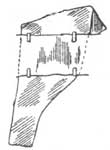

 The Holster form is unknown and could have been cut webbing, folded and stitched to a Sam Browne Pistol case form, which Mills had illustrated in a Patent of 1910 (far left). Before 1913, M.W.C.B.Co., the American parent company, were illustrating more angular holsters for U.S. revolvers and automatics, which had barrel sections woven, the remaining profile being completed by stitching (centre left). By 1916, Mills Web Equipment for Officers had an integrally-woven, flat Holster (near left). This example is maker marked "M.E. Co." and dated 1917. From the Paul Hannon Collection.Any one of these designs may have been used, but see below.
The Holster form is unknown and could have been cut webbing, folded and stitched to a Sam Browne Pistol case form, which Mills had illustrated in a Patent of 1910 (far left). Before 1913, M.W.C.B.Co., the American parent company, were illustrating more angular holsters for U.S. revolvers and automatics, which had barrel sections woven, the remaining profile being completed by stitching (centre left). By 1916, Mills Web Equipment for Officers had an integrally-woven, flat Holster (near left). This example is maker marked "M.E. Co." and dated 1917. From the Paul Hannon Collection.Any one of these designs may have been used, but see below.

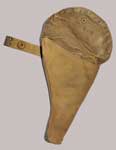
 In the Paul Hannon Collection there is this stylish folded and stitched Holster – not made by Mills - just like the Patent drawing. It is closed with a standard Mills press stud on a tab strap, properly brass tipped. This may be a “user-mod”, but it does have a “quality” look to it, as though it was “manufactured”. Photos this section © Paul Hannon 2010.
In the Paul Hannon Collection there is this stylish folded and stitched Holster – not made by Mills - just like the Patent drawing. It is closed with a standard Mills press stud on a tab strap, properly brass tipped. This may be a “user-mod”, but it does have a “quality” look to it, as though it was “manufactured”. Photos this section © Paul Hannon 2010.
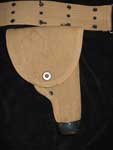
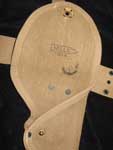 These colour photos, from the John Pierson Collection, show the Mills W.C.B.Co. Holster supplied to the Canadian army. This example carries Mills’ “bullet T.M.” and is dated 1914. From the John Pierson Collection, photos © John Pierson 2010.
These colour photos, from the John Pierson Collection, show the Mills W.C.B.Co. Holster supplied to the Canadian army. This example carries Mills’ “bullet T.M.” and is dated 1914. From the John Pierson Collection, photos © John Pierson 2010.
SWORD HOOKS
SWORD-HOOK HOLDERS
Listed un-alphabetically, two further mystery items completed the set. The Holders and the Hooks were priced in dozens, which gives an individual piece of one half-penny (ha’penny as we older types once called them!). It suggests they were both metal items and were small. Even the shortest length of webbing had a price, which would have driven the unit price above one ha’penny, ergo there was no webbing involved. It also requires a leap of faith in accepting the ascribed nomenclature, which give no clues. A Hook could be open, or a “dog-clip”, whilst a Holder might just be a brass loop. With no Sword frog, were these some form of adaptor, whereby the leather “Sam Browne” Frog could be carried? Readers – all suggestions welcomed!